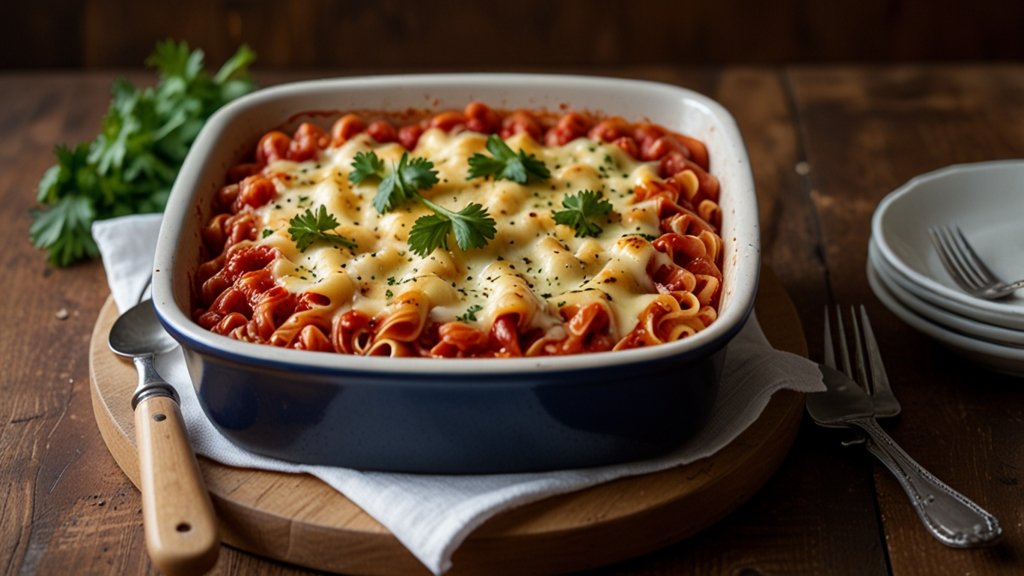Picture this: It’s a chilly Sunday evening. The comforting aroma of simmering tomato sauce, rich with garlic and herbs, fills the kitchen. Nestled beneath a blanket of melted, golden mozzarella cheese, plump tubes of pasta cradle a creamy, savory filling. This isn’t just any baked pasta dish; this is the heartwarming embrace of Mannacote. If that name sounds slightly unfamiliar compared to “manicotti,” you’re not alone – and that’s the delicious story we’re diving into today.
Mannacote isn’t a typo or a brand-new invention. It’s a beautiful example of how language, especially in the melting pot of American home cooking, evolves organically. It represents the very same beloved Italian-American baked pasta dish known officially as manicotti, but spelled and pronounced just a little differently, passed down through generations on recipe cards and whispered in family kitchens. It’s pure, unadulterated comfort on a plate, a testament to the power of tradition and the delicious variations born in home ovens.
What Exactly is Mannacote? Decoding the Deliciousness
At its core, Mannacote is large, tubular pasta. Think substantial cylinders, perfect vessels for holding a generous amount of filling. The magic happens when these tubes are stuffed, typically with a luscious blend of ricotta cheese. This ricotta base often gets elevated with additions like fresh parsley for brightness, perhaps some grated Parmesan or Pecorino Romano for depth, maybe an egg for binding, and sometimes even ground meat (like beef, sausage, or pork) for a heartier profile.
Once stuffed, the Mannacote tubes are lovingly arranged in a baking dish. They’re then generously smothered in a vibrant, usually tomato-based sauce – think marinara or a simple, seasoned tomato sauce. The crowning glory? A thick layer of shredded mozzarella cheese. The whole ensemble then goes into the oven, baked until the sauce is bubbling around the edges and that mozzarella topping transforms into a glorious, stretchy, golden-brown crust. The result is a harmonious, satisfying casserole that’s creamy, cheesy, saucy, and utterly irresistible.
Mannacote vs. Manicotti: Untangling the Noodle (and the Name)
So, if Mannacote is essentially manicotti, why the different name? The key lies in linguistics and regional dialects.
- Manicotti (The Official Term): This is the standard Italian name for the dish and the pasta shape itself. It comes from the Italian word “manicotto,” which literally means “little sleeve” or “muff,” a perfect description of the tubular pasta designed to hold a filling. You’ll find “manicotti” in Italian cookbooks, restaurant menus, and on pasta packaging.
- Mannacote (The Vernacular Variant): This spelling is a quintessential example of Americanized pronunciation finding its way onto paper. Over time, as Italian immigrants settled across the US, regional accents and colloquial speech influenced how words were heard and subsequently spelled. “Manicotti” (pronounced something like mah-ni-KOT-tee in Italian) likely morphed in certain communities or family circles to sound more like “manna-COAT” or “manna-COTE.” When written down phonetically, Mannacote was born. It’s less about a different recipe and more about a different way of saying and spelling the familiar dish within the context of American home cooking traditions. You won’t find “Mannacote” in traditional Italian culinary dictionaries, but you absolutely will find it cherished in countless family recipe collections.
The Mannacote & Manicotti Connection: A Quick Reference
| Feature | Mannacote | Manicotti | Essentially… |
|---|---|---|---|
| Core Dish | Stuffed tubular pasta baked in sauce & cheese | Stuffed tubular pasta baked in sauce & cheese | The same beloved dish. |
| Origin | Evolved from “manicotti” within American home cooking vernacular. | Standard Italian term (“manicotto” = little sleeve). | Mannacote is a phonetic variant. |
| Recognition | Primarily found in family recipes, regional American cooking contexts. | Recognized globally, used in restaurants, cookbooks, and on pasta packaging. | Different names, same soul. |
| Pasta Shape | Large tubes (crepes sometimes used alternatively). | Large tubes (crepes sometimes used alternatively). | Identical or interchangeable. |
| Key Takeaway | A regional/spelling variant representing the classic Italian-American comfort food experience. | The traditional Italian name for the dish and pasta. | Two paths to the same cheesy, saucy destination! |
Also Read: IntrepidFood.eu | Exploring European Culinary Flavors
Crafting the Perfect Mannacote: A Step-by-Step Journey
Ready to bring the comfort of Mannacote into your own kitchen? Here’s a roadmap to success:
- Gather Your Arsenal (Ingredients):
- The Tubes: 1 box (approx 8 oz) manicotti pasta tubes. Look for ones specifically labeled “manicotti” – they’re the right size. Pro Tip: No pre-boiling needed for many modern brands! Check the box for oven-ready instructions – it saves time and prevents tearing.
- The Heart (Filling): 15-16 oz whole milk ricotta (drain any excess liquid), 1 large egg, 1-1.5 cups shredded mozzarella (divided), 1/2 cup grated Parmesan or Romano, 2-3 tbsp chopped fresh parsley, pinch of nutmeg (optional, but classic), salt & pepper to taste. Variation: Sauté 1/2 lb ground beef or Italian sausage, drain well, and mix into the filling.
- The Embrace (Sauce): 3-4 cups of your favorite marinara or homemade tomato sauce. Simmer it gently while you prep.
- The Crown: Additional 1-1.5 cups shredded mozzarella (or a mix of mozzarella and provolone).
- The Extras: Cooking spray or olive oil for the baking dish.
- Preheat & Prep: Preheat your oven to 375°F (190°C). Lightly grease a 9×13 inch baking dish. Spread about 3/4 cup of the sauce thinly over the bottom.
- Create the Creamy Core: In a large bowl, combine the ricotta, egg, 1 cup of the mozzarella, all of the Parmesan/Romano, parsley, nutmeg (if using), salt, and pepper. Mix gently but thoroughly until well blended. If using meat, fold it in now.
- Fill Those Sleeves (The Fun Part!):
- Pastry Bag Method (Easiest & Cleanest): Spoon the filling into a large pastry bag fitted with a plain tip (or just snip the end off a disposable bag). Gently insert the tip into one end of a manicotti tube and squeeze until the tube is filled evenly (but don’t overstuff!). Place seam-side down in the prepared baking dish. Repeat.
- Spoon Method: Carefully spoon the filling into each tube using a teaspoon. This takes a bit more patience but works! Hold the tube over the bowl and gently push the filling down.
- Ziploc Bag Hack: Spoon filling into a sturdy gallon-sized Ziploc bag. Snip off one corner (about 1/2 inch) and use like a pastry bag.
- Assemble the Masterpiece: Arrange all the filled Mannacote tubes in a single layer over the sauce in your baking dish. Pour the remaining sauce evenly over the top, ensuring all the pasta is covered (this prevents drying out). Sprinkle the remaining mozzarella cheese generously and evenly over the sauce.
- Bake to Bubbly Bliss: Cover the baking dish tightly with aluminum foil. Bake for 40 minutes. Carefully remove the foil. Continue baking, uncovered, for another 15-20 minutes, or until the cheese is melted, golden, and bubbly, and the sauce is hot throughout. Tip: If the cheese isn’t browning to your liking, pop it under the broiler for 1-2 minutes at the end (watch CLOSELY!).
- The Crucial Rest: Remove from the oven and let the Mannacote rest for 10-15 minutes before serving. This allows the filling to set slightly, making it much easier to serve without everything oozing out. The flavors also meld beautifully during this rest.
- Serve & Savor: Plate up those beautiful, saucy, cheesy tubes! Garnish with extra fresh parsley if desired. Pair with a crisp green salad and some crusty bread for mopping up every last drop of sauce.
Why Mannacote Wins the Comfort Food Crown
Beyond its deliciousness, Mannacote embodies what makes comfort food truly special:
- Feeds a Crowd: It’s inherently a dish for sharing, perfect for family dinners, potlucks, or feeding hungry guests.
- Make-Ahead Marvel: Assemble the entire dish hours ahead, refrigerate, and bake when needed. It even freezes beautifully before or after baking. (See FAQs!)
- Endlessly Adaptable: Vegetarian? Skip the meat. Love spinach? Thaw, drain, and chop a 10oz box of frozen spinach and mix it into the ricotta. Prefer a meaty sauce? Use a robust Bolognese instead of marinara. The ricotta filling is a welcoming canvas.
- Nostalgia on a Plate: For many, the aroma and taste of baked Mannacote instantly transport them back to childhood kitchens and cherished family gatherings.
- Satisfaction Guaranteed: The combination of creamy filling, tender pasta, vibrant sauce, and gooey cheese is simply unbeatable for pure, hearty satisfaction.
Beyond the Basics: Mannacote Variations to Explore
While the ricotta-based classic reigns supreme, the world of Mannacote offers room for delicious exploration:
- The “Crepe” Controversy: In some regions and families, Mannacote filling is wrapped in delicate, homemade crepes instead of pre-formed pasta tubes. This creates an even more tender, almost silky bite. It’s more labor-intensive but a revered tradition for some. (Infographic Idea: Side-by-side visual of tube vs. crepe Mannacote)
- Four-Cheese Fiesta: Amp up the cheese quotient by adding shredded fontina or asiago to the ricotta filling, or using a blend of mozzarella, provolone, asiago, and parmesan on top.
- Veggie Powerhouse: Incorporate finely chopped sautéed mushrooms, zucchini, bell peppers, or roasted eggplant into the ricotta filling for extra flavor and nutrition.
- Pesto Swirl: Add a dollop of basil pesto to the ricotta filling or swirl some into the tomato sauce before topping with cheese.
- White Sauce Wonder: Swap the tomato sauce for a creamy béchamel or Alfredo sauce for a decadent, rich twist. Top with mozzarella and perhaps some crispy pancetta bits.
Your Mannacote Mission: Bringing Comfort Home
The journey of Mannacote – from the Italian “manicotto” to the American family table – is a beautiful reminder of how food traditions evolve and become deeply personal. It’s a dish less about rigid authenticity and more about the love and comfort poured into it. Whether you call it Mannacote or manicotti, the result is the same: a warm, cheesy, saucy embrace that feels like home.
So, what are you waiting for? Grab that box of pasta tubes (or whip up some crepes!), mix up a bowl of creamy ricotta filling, simmer your favorite sauce, and get ready to bake up a dish steeped in tradition and overflowing with flavor. Your own Mannacote masterpiece awaits!
You May Also Read: Cream Berry Fairy Recipe & Flavor Guide
FAQs
Is Mannacote actually different from manicotti?
No, the recipe isn’t fundamentally different. Mannacote is primarily a regional or family-specific spelling and pronunciation of the dish known everywhere else as manicotti. It refers to the same stuffed pasta bake.
Can I use no-boil lasagna noodles instead of manicotti tubes?
Absolutely! This is a popular hack. Simply par-boil the lasagna noodles for a minute or two until pliable (or use oven-ready ones following box instructions). Lay them flat, spread the ricotta filling down the center, roll them up, and place seam-side down in the sauce. Voila! Rolled Mannacote.
My ricotta filling is runny! How do I fix it?
Drain the ricotta well in a fine-mesh strainer for 15-30 minutes before mixing. Ensure your cooked meat (if using) is thoroughly drained and cooled. Adding an extra tablespoon or two of grated Parmesan or breadcrumbs can also help absorb excess moisture.
Can I freeze Mannacote?
Mannacote freezes exceptionally well! You have two great options:
- Assemble & Freeze (Unbaked): Assemble the dish completely (filled tubes, sauce, cheese). Cover tightly with plastic wrap and then foil. Freeze for up to 2-3 months. Bake from frozen, adding at least 30-45 minutes to the covered baking time (remove plastic wrap first!).
- Freeze Leftovers (Baked): Portion out baked Mannacote, let cool completely, and freeze in airtight containers for up to 2 months. Reheat gently in the oven or microwave.
What can I substitute for ricotta cheese?
While ricotta is traditional, you can use:
- Cottage Cheese: Blend small-curd cottage cheese until smooth for a similar texture and tang.
- Firm Tofu: Blend firm tofu (pressed to remove water) with nutritional yeast, lemon juice, and seasonings for a dairy-free option (texture will be different).
- Mascarpone: Too rich alone, but mixing a little with ricotta adds luxurious creaminess.
Why did my pasta tubes split while baking?
This usually happens if the tubes were overfilled or if they weren’t fully covered in sauce. The sauce keeps the pasta moist during baking. Ensure tubes are filled firmly but not bursting, and that sauce completely covers them before adding cheese. Using oven-ready tubes also minimizes splitting.
Where did the name “Mannacote” come from?
It’s almost certainly a phonetic spelling born in American home kitchens. As the Italian word “manicotti” (pronounced mah-ni-KOT-tee) was passed down through generations and across regions, the pronunciation likely shifted in some communities to sound like “manna-COAT.” When written down based on how it was said, Mannacote emerged. It’s a charming piece of culinary linguistic evolution!










